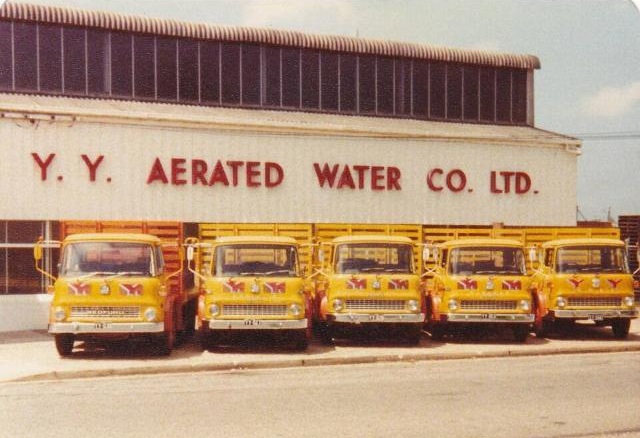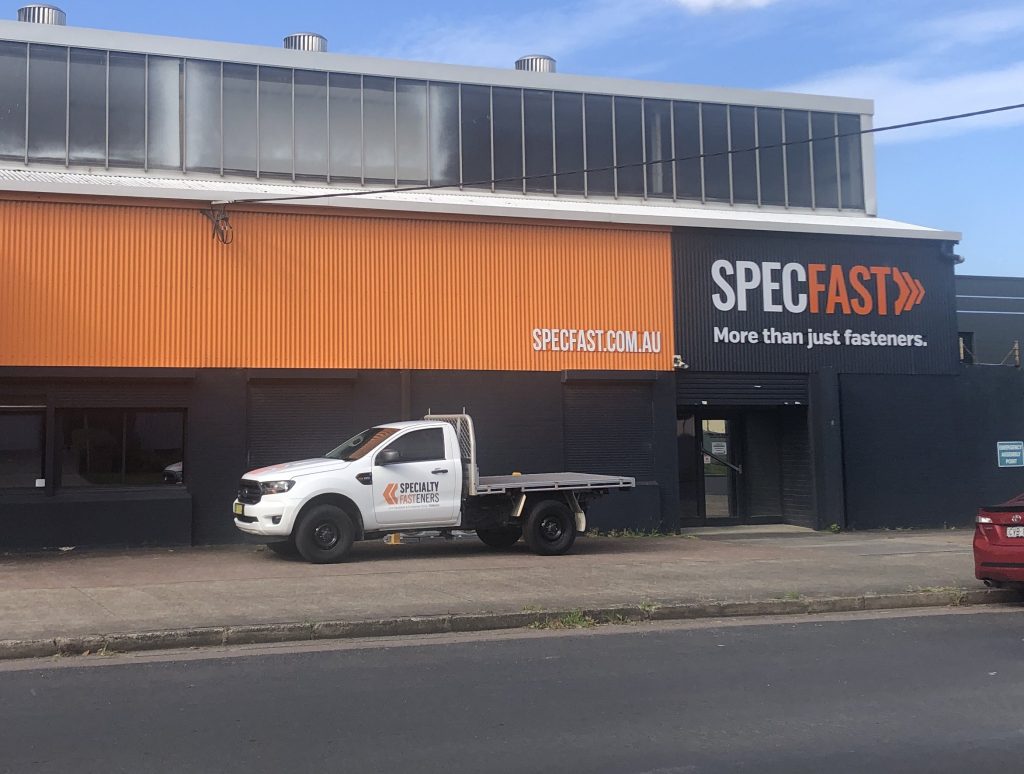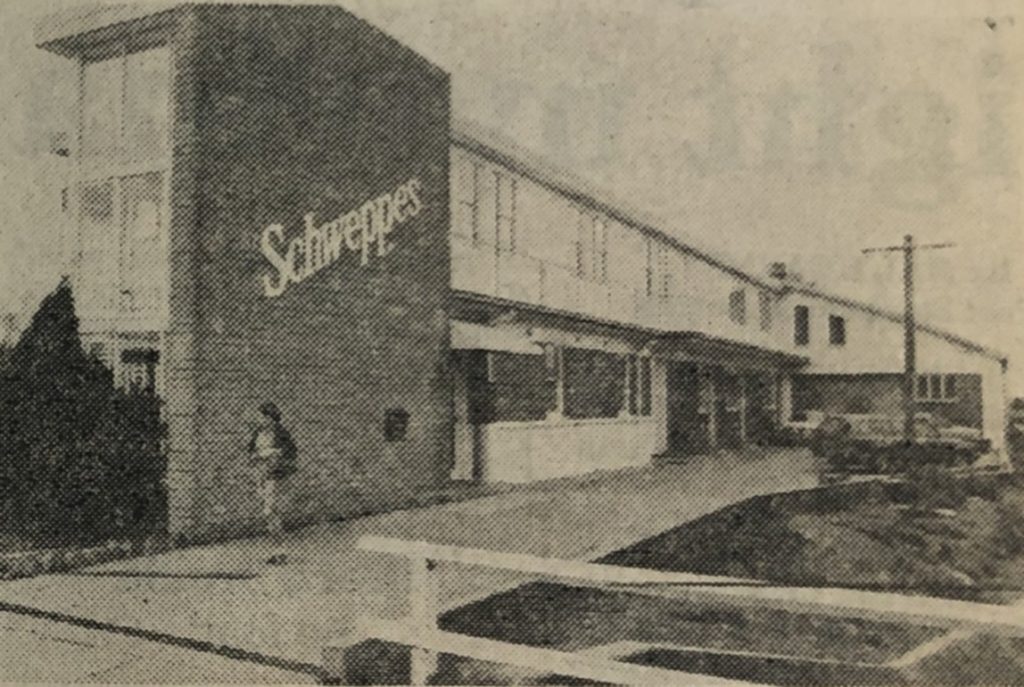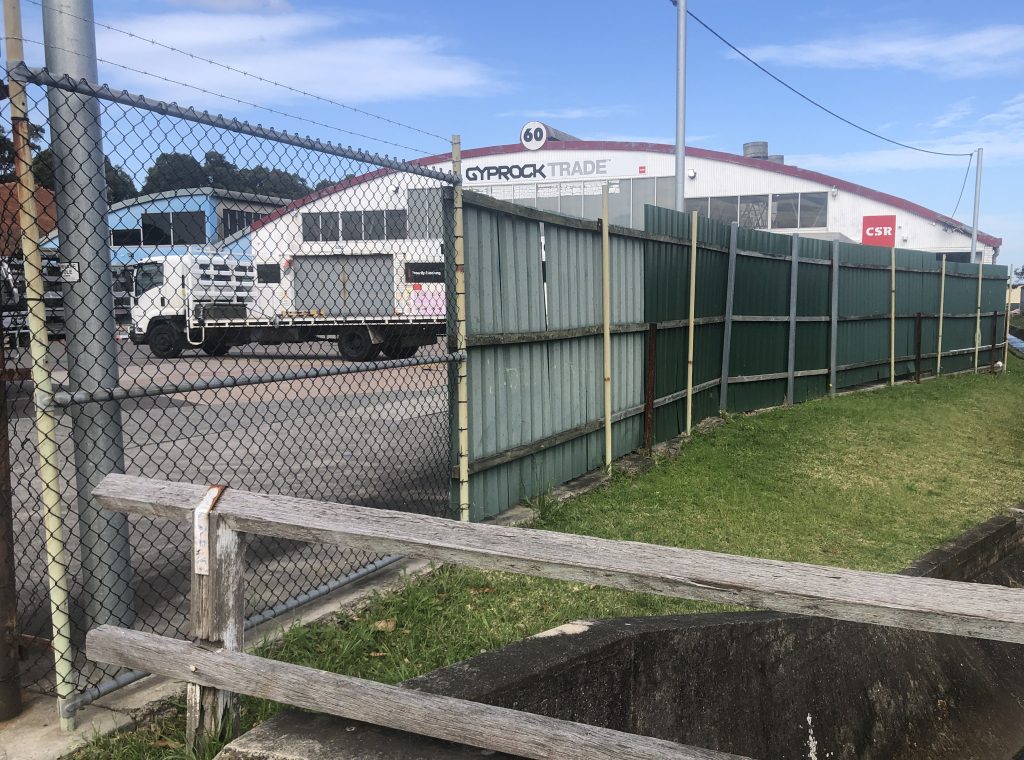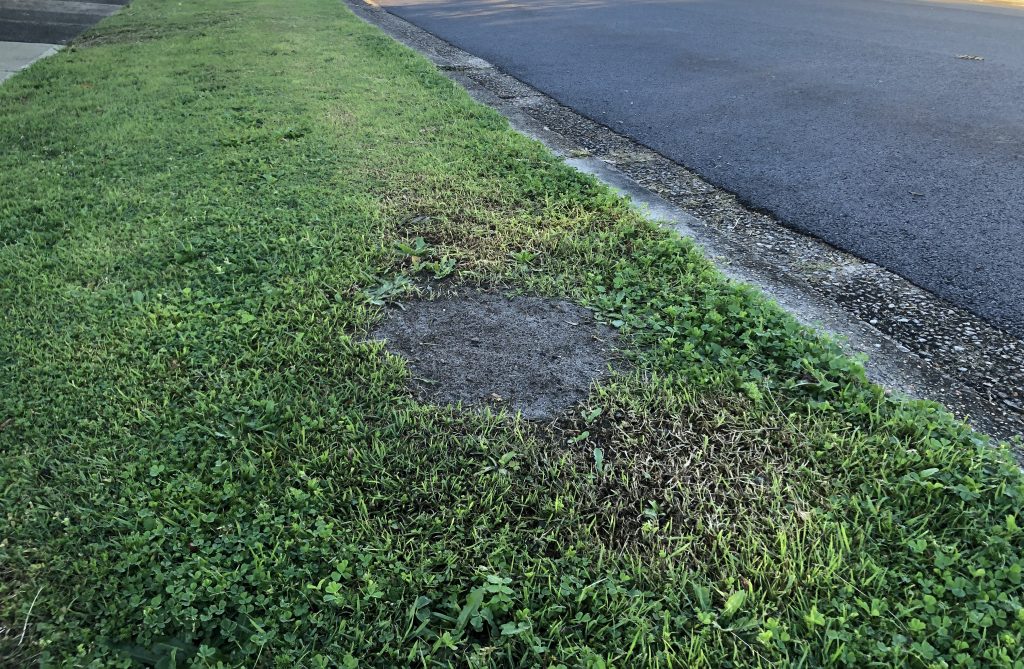Ralph Snowball photographed William Lahay’s family butcher shop in Morehead Street Lambton, 125 years ago this month. Little is known about Lahay, although another photograph shows that in 1902 his business had moved to Elder Street in a small wooden building where butchers Joseph Palmer had previously traded, and Edward Box would trade from 1903.
At this time butchers obtained their meat from nearby slaughterhouses, whose disagreeable stench and health risks were a persistent concern. In April 1876, the Mayor of Wickham, James Hannell, had written to the Colonial Secretary expressing “the absolute necessity for the erection by the Government of a public abattoirs, there being at the present time no less than fourteen licensed slaughterhouses in the district, most situated in the midst of, or near to a rapidly increasing population.”
The Government denied any responsibility, replying that it was up to the local councils to act. And so began decades of to-and-fro on the need for a district abattoir, where it should be located, and who should pay for it. In the 1890s the matter gained momentum with the municipalities holding many conferences. Several sites were suggested including Shortland, and Ironbark Hill at the north of Sandgate.
In 1913 the authorities chose a site in Mayfield West adjacent to the railway, allowing a short branch line to be constructed. The Newcastle Abattoir finally opened on 3 June 1916, forty years after James Hannell’s letter of 1876! It operated for seven decades, and when the cost of upgrading equipment to meet new export requirements could not be justified, it closed in 1981. It was soon demolished and the suburb of Warabrook grew in its place. Newcastle’s meat was then sourced from other rural and regional facilities. In the time of Lahay’s butcher shop, people could see their meat supplied from local suburbs. Today’s sources are out of sight and far away, sometimes surprisingly so. It may astonish many to learn that 75% of the packaged bacon and ham currently consumed in Australia is imported.


The article above was first published in the August 2025 edition of The Local.
Lahay’s Butcher
Elder St Shop
In March 1874 Joseph Palmer, butcher, purchased lot 9 of Section E in Lambton. (Vol-Fol 106-208) and as early as October 1874 he is mentioned as being a butcher on Elder Street. In October 1884 the paper reported that …
Mr. Joseph Palmer has just had the foundations laid for a two-story brick dwelling-house and butcher’s shop, in Elder-street, which, when erected, will be another valuable addition to the street.
Newcastle Morning Herald and Miners’ Advocate, 11 October 1884.

After the death of Joseph Palmer on 19 January 1901, his house, effects and shop were put up for auction on 27 August 1901, with the advertisement of 16 August 1901 noting “a W.B. Butcher’s Shop, occupied by Mr. Lahay.” An April 1902 photograph shows the shop with Lahay’s name on the verandah side.

On 23 September 1903, Stephen Richardson purchased Palmers’ house and shop, by October 1903 Richardson’s brother-in-law Edward Box was trading as a butcher in that location, and continued there until about 1915.

A 1922 plan shows that the shop is occupied by a butcher named “Bush”.

establishing the location of Lahay’s 1900 shop
Snowball’s 1900 photograph of Lahay’s butcher shop is in some places captioned with a location of De Vitre Street. This identification is possibly because the Federal Directory of Newcastle and District 1901 has on page 93 an entry for “Lahey, W., De Vitre st” in the list of Lambton butchers. Land title Vol-Fol 878-207 shows that “William Lahay, Butcher” purchased a portion of Lot 13 Sec C on De Vitre St on 29 April 1889. However this lot is on the north side of the street and would have the North Lambton hill behind it, and is clearly not the location of Snowball’s photo.
In the photo we see that the street has a marked slope down to the left, and in the far background there is a hill with a cleared section and trees on the horizon. This is more suggestive of a location on the west side of the upper section of either Grainger or Morehead Streets. Looking at land titles on those streets for possible connections with a butcher reveals a block of land owned by Nathaniel Elliott (butcher) from 1888 to 1903. (Vol-Fol 193-3)

Inspecting that block of land (41 Morehead St) shows the house on the right side of Lahay’s shop in the 1900 photo appears to still be there today, although with the verandah roof no longer extending over the footpath.



As a final confirmation of the location, in the photo to the left of the butcher is a house set back from the street (1) and in the background a two storey building (2) with an odd slope up of the roof line at the left hand side.

Using a 1909 Water Board map, and drawing a line from the suspected butcher shop (B) through the corner of the set-back house (1) the line passes through a thin building on Elder St (2).

That building still stands today (at 102 Elder St) and photographing it from the rear shows it to be the same building, minus the chimney.

The verandah roof of both the house and the shop can be seen in the background of an October 1900 Lambton colliery photo.
District Abattoir
Prior to the establishment of a district abattoir in North Waratah, butchering of animals was conducted in a variety of small slaughter-houses around the towns and suburbs of Newcastle. Some examples of these include the slaughter-house of A L Payne of Lambton, and the meat-works at Waratah.








The new suburb of Warabrook was officially named on 7 December 1984.
The Greater Newcastle Permanent Building Society is one of three financial backers along with the Kern Corporation and the Newcastle Master Builders’ Association for a prestige display village at the new Warabrook Gardens Estate being developed on one of the last remaining tracts of residential land close to Newcastle.
The Canberra Times, 12 May 1985.

Newspaper articles
| Article Date Event Date | Notes |
|---|---|
| 29 Apr 1876 | James Hannell, Mayor of Wickham, writes to the Colonial Secretary regarding the need for public abattoirs: “There are, at the present time, no less than fourteen licensed slaughter-houses in the police district, most of them being situated in the midst of, or near to, a rapidly increasing population, and, in which, on the average, no less than 200 bullocks, 1200 sheep, besides pigs, calves, &c., are slaughtered every week. The whole of the medical gentlemen residing and practising in the district of Newcastle, assert most , positively, I am told, that the noxious effluvia arising from these establishments, as at present conducted, has for many years past, and especially during the late drought, been the principal cause of the spread of disease in its worst form all over the district.” |
| 9 May 1876 | The editor of the Newcastle Chronicle supports Hannell's call for erection of public abattoirs, and suggests the North Shore (Stockton) as a possible location. |
| 18 May 1876 | "I am directed by the Colonial Secretary to inform you that the Government have no power, so far as is known, to cause the erection of abattoirs, and that this matter seems to be one in which the inhabitants of Newcastle and the surrounding municipalities should move for themselves." |
| 22 Mar 1890 | A meeting at Wallsend "to take further steps to urge the councils to have the slaughter-houses removed. The township was almost completely surrounded with slaughter yards, and no matter from what quarter the winds of Heaven were driven, with them came the odour, that in the opinion of those present was decidedly objectionable." |
| 1 Aug 1893 | Sites at Tarro and Ironbark Hill have previously recommended as possibilities for the abattoir. |
| 12 Sep 1896 11 Sep 1896 | Motion at the municipal abattoir conference"That this conference is of the opinion that it is important, in the interests of the public health, to have abattoirs erected in order that a more rigid inspection may be made of all animals slaughtered for food for the people of this district." |
| 19 Mar 1897 | Inspection of two candidate sites for the abattoir. 1. Old House Paddock on Wallsend Company's Estate. 2. Ironbark Hill on the Hexham road. 3. Waratah side of Sandgate Cemetery. The Ironbark Hill site was favoured: "This land, which is owned by the A.A. Company, was found to be most suitable for the erection of abattoirs, being perfectly drained, with the tidal waters below to wash away the slush; and, in addition to this, it was considered to be most central to Maitland and Newcastle, possessing an easy access from both sides." |
| 30 Sep 1898 29 Sep 1898 | "A deputation from the municipalities of the Newcastle and Maitland districts waited on the Premier yesterday to urge that steps be taken to establish central abattoirs for those districts. If anything was done it would be necessary to make killing illegal at any other place." |
| 29 Mar 1899 27 Mar 1899 | Alderman Asher moved in the City Council meeting on Wednesday night, "That an application be made to the A.A. Company and the Wallsend Company for a statement of the terms on which they will be prepared to sell 10 or 20 acres of land near the Sandgate railway station, suitable for the establishment of cattle sale yards." |
| 14 Dec 1904 13 Dec 1904 | Municipal conference "or the purpose of considering the construction and establishment of an abattoir and cattle saleyards for the city and district." |
| 19 Nov 1908 | "The proposal to erect stock saleyards and abattoirs for the Newcastle district is one that has engaged the attention of the local municipal authorities for a considerable time. Owing to the growth of population and the expansion of the suburban area, the necessity of abolishing the various slaughtering establishments, which have become surrounded by settlement, and the substitution of a properly regulated abattoir system, has been forced upon the local authorities. This afternoon the Mayor of Newcastle (Ald. Cook), along with representatives from the various municipalities and shires in the district, visited a site on Ironbark Creek, near its junction with the Hunter River, and the opinion was expressed that it was a suitable one for saleyards and abattoirs. Its area comprises from 80 to 100 acres, and is bordered on one side by the Great Northern railway, and on the other by the south arm of the Hunter, so that it could be easily served by both rail and water carriage. A ridge runs along the centre of the land, affording an excellent fall on both sides, and the drainage is good." |
| 23 Sep 1909 22 Sep 1909 | Another municipal conference, still discussing possible sites. "The site chosen by the committee some time ago was on Ironbark Hill, but the cost of resumption was quite beyond their anticipation." Discussion on an "an alternative site between Sandgate and Wallsend, on the left side of the railway. The site was an elevated one, with perfect drainage, and there were hundreds of acres of land which could be bought for a reasonable sum. In every respect the site was preferable to that chosen at Ironbark. The latter site was altogether too public, but the one proposed was out of sight, and was easy of access, both by rail and road, in addition to which it was central, and had the advantage of water for drainage purposes." |
| 22 Jan 1910 | Inspection of potential abattoir site at Shortland. "The land is owned by the Newcastle-Wallsend Coal Company, and the area inspected is known as the Old House Paddock, and contains 316 acres. Practically the whole of it is high ground, sloping away to Ironbark Creek on the west. It is only half a mile from the Great Northern Railway, and there appears to be no difficulty in the way of running a branch line in from a point near Sand gate Railway Station. Practically no cutting or filling would be needed. It is the site which has been favoured by Dr. Dick as being in many ways preferable to that at Ironbark Hill." |
| 3 Feb 1910 2 Feb 1910 | A conference of municipal representatives to deal with the abattoir question. The "old house paddock" site between Wallsend and Sandgate was discussed as a suitable site. |
| 15 Feb 1910 | "The fact that Dr. Ashburton Thompson has approved of the site for the proposed abattoirs in the old House Paddock, at Ironbark Creek, which is within the Tarro Shire area, has called forth a protest from the Tarro Shire Council. " |
| 21 Jun 1911 | "The A. A. Company has men engaged clearing the large paddock north of the Great Northern Railway, and between the western municipal boundary of Waratah and the road leading from the high-level bridge to Maitland road. The purpose of clearing is to make the land ready for the construction of stock saleyards. The site is a suitable one for the object contemplated, and although within Tarro Shire, it is immediately adjacent to Waratah, which place should certainly benefit by the saleyards." |
| 27 Nov 1912 | Passing of the Newcastle District Abattoir and Sale-yards Act. |
| 6 Mar 1913 5 Mar 1913 | Official opening of Waratah saleyards. "The yards cover an area of 10½ acres, and consist of 70 sheep yards, and 10 cattle yards, providing accommodation for from 4000 to 5000 sheep, and from 400 to 500 cattle, while an area of about 700 acres has been subdivided and fenced as rest paddocks." |
| 10 Apr 1913 | "As yet there was no site decided upon for the erection of abattoirs. Three sites were being considered." |
| 25 Apr 1913 24 Apr 1913 | "After discussion the board selected the site on the west of the A.A. Company's cattle sale yards at Waratah as the most suitable." |
| 10 May 1913 9 May 1913 | A municipal conference upholds the selection of Waratah site despite a protest from Wallsend Council. The Old House Paddock site was rejected principally because of concern that drainage into Ironbark creek would make its way up to Wallsend. |
| 24 Oct 1913 23 Oct 1913 | "The secretary [of the Abattoir Board] submitted a report as to the clearing of the abattoir site, recommending that twenty acres be cleared and grubbed as soon as possible, and submitted draft specification of the work to be done." |
| 4 Sep 1914 2 Sep 1914 | Tenders accepted for construction of abattoir. |
| 1 Feb 1915 30 Jan 1915 | Foundation stones of abattoir laid. Completion anticipated in 14 months. |
| 16 Aug 1915 | "A letter was received from the Railway Commissioners, forwarding plan and estimate of cost for siding from the present stock siding at the Wallsend Junction to the abattoirs." |
| 7 Sep 1915 | "TENDERS. Newcastle.- Construction of a branch railway, including earthwork, from the sale-yards siding at Waratah to the Newcastle District Abattoirs, a distance of 40 chains." |
| 25 May 1916 | "Mr. Creer said that the construction work had been practically completed for several weeks past, but the use of the abattoir had been delayed, pending an agreement with the Federated Meat Trade Employees' Union of Australasia, as to the working conditions and wages, and also the gazetting of the bylaws." |
| 3 Jun 1916 2 Jun 1916 | A dispute with the Federated Meat Trade Employees' Union of Australasia preventing commencent of operations at the new abattoir was resolved when the union "decided to accept an interim agreement with a view to work being commenced as soon as possible." |
| 31 Dec 1917 3 Jun 1916 | "The abattoir was opened for use of 3rd June, 1916, and the present is therefore the first complete year's working." |
| 14 Jul 1916 | "The Newcastle Abattoir Board has is sued a notification prohibiting after to morrow the slaughtering of any cattle within a radius of 14 miles of the New castle Post Office, except at the board's abattoir. " |
| 11 Aug 1916 | Inspection of the abattoirs by "about ninety aldermen and councillors of the constituent municipalities… The party were conveyed along the company's siding from the main line to the area of the abattoirs, where they detrained." |












































